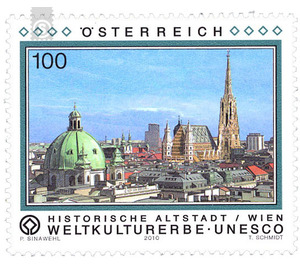UNESCO world heritage - Austria / II. Republic of Austria 2010 - 100 Euro Cent
Theme: Organiszations & Institutions
| Country | Austria / II. Republic of Austria |
| Issue Date | 2010 |
| Face Value | 100.00 |
| Edition Issued | 160,000 |
| Printing Type | combination printing |
| Stamp Type | Commemorative |
| Item Type | Stamp |
| Chronological Issue Number | 2237 |
| Chronological Chapter | OOS-OE2 |
| SID | 679199 |
| In 55 Wishlists | |
With the present special stamp "Historic Old Town of Vienna", the popular brand series "World Heritage UNESCO" now finds its attractive conclusion. The brand image shows the world-famous "skyline" of Vienna's city center with St. Stephen's Cathedral and St. Peter's Church in the foreground. The Inner City is also the 1st district of Vienna; until the gradual incorporations from the year 1850, it was also largely congruent with the former urban area. Originally, the city center was divided into four quarters, which were named after important city gates: the Stubenviertel in the northeast, the Carinthian district in the southeast, the Widmerviertel in the southwest and the Schottenviertel in the northwest. The old town is bordered by the Ringstrasse, where numerous famous buildings (State Opera, Burgtheater, Parliament, City Hall, Natural History and Art History Museum, University, etc.) stand. The history of Vienna, the capital of Austria, begins some 4,000 years ago. Because of its location on the Danube, between the foothills of the pre-Alps, the so-called "Wienerwald", and the Pannonian lowlands, today's metropolis is one of the early settlement areas of the people and became increasingly important as a trading center and strategic point in the heart of Europe. The origins of the Inner City go back to a Celtic settlement and later to the Roman legion camp Vindobona. To this day, the city center is not only the political, economic and spiritual center of Vienna, but also that of the entire Republic of Austria. Without question, the closed ensemble of the historic center of Vienna is one of the most beautiful city monuments in Europe. Three epochs characterize the face of the former royal residence of the Habsburg emperors: the Middle Ages with the skyward Gothic St. Stephen's Cathedral, the Baroque period, whose most significant legacy is the Hofburg with its sumptuous domes, and the Ringstraße era of the late 19th century. Of course, the many impressive churches, palaces and parks contribute to the incomparable flair of the old town of Vienna. Just as inextricably linked to the old town, however, are the enjoyment of Viennese cuisine, the charming ambience in the traditional coffee houses and the proverbial cosiness that reigns among the old city heirs.


